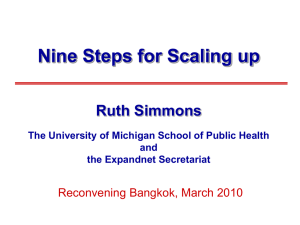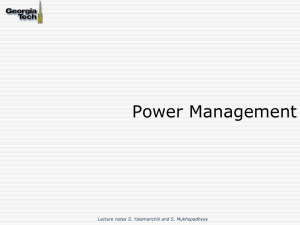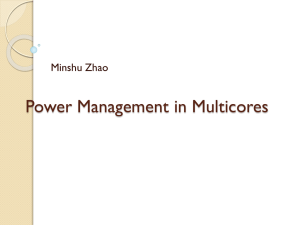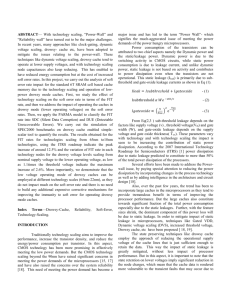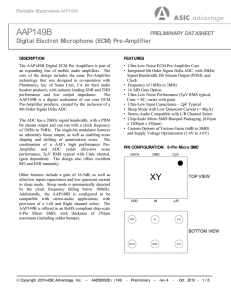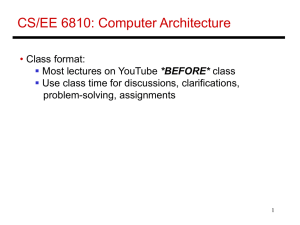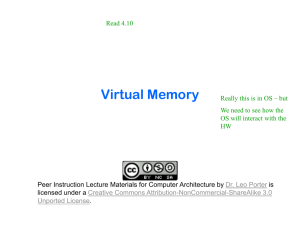ppt - ECE Users Pages
advertisement
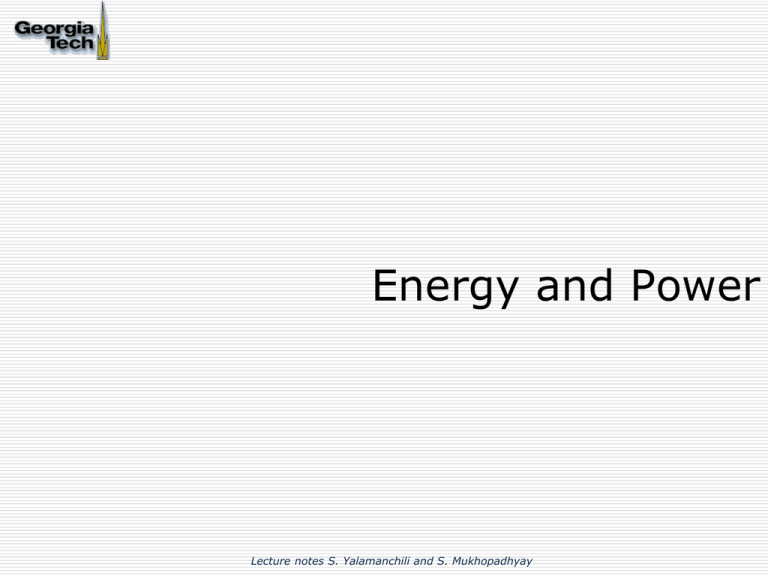
Energy and Power Lecture notes S. Yalamanchili and S. Mukhopadhyay Some Useful Reading • http://en.wikipedia.org/wiki/CPU_power_dissip ation • http://en.wikipedia.org/wiki/CMOS#Power:_sw itching_and_leakage • http://www.xbitlabs.com/articles/cpu/display/c ore-i5-2500t-2390t-i3-2100t-pentiumg620t.html • http://www.cpu-world.com/info/charts.html (2) Historical Scaling (3) Technology Scaling GATE GATE DRAIN SOURCE tox DRAIN SOURCE BODY L • 30% scaling down in dimensions doubles transistor density P CV dd f V dd I st V dd I leak 2 • Power per transistor Vdd scaling lower power • Transistor delay = Cgate Vdd/ISAT Cgate, Vdd scaling lower delay (4) Fundamental Trends 2004 2006 2008 2010 2012 2014 2016 2018 90 65 45 32 22 16 11 8 Integration Capacity (BT) 2 4 8 16 32 64 128 256 Delay = CV/I scaling 0.7 ~0.7 >0.7 Delay scaling will slow down >0.35 >0.5 >0.5 Energy scaling will slow down High Volume Manufacturing Technology Node (nm) Energy/Logic Op scaling Bulk Planar CMOS High Probability Low Probability Alternate, 3G etc Low Probability High Probability Medium Variability ILD (K) RC Delay Metal Layers High ~3 <3 1 1 1 6-7 7-8 8-9 Very High Reduce slowly towards 2-2.5 1 1 1 1 1 0.5 to 1 layer per generation Source: Shekhar Borkar, Intel Corp. (5) ITRS Roadmap for Logic Devices From: “ExaScale Computing Study: Technology Challenges in Achieving Exascale Systems,” P. Kogge, et.al, 2008 (6) Where Does the Power Go in CMOS? • Dynamic Power Consumption Charging and discharging capacitance • Short Circuit Power Short circuit path between supply rails during switching Nominally 10%-20% of dynamic power and can be ignored for a first order analysis • Leakage Leaky transistors (7) Dynamic Power • Dynamic power is used in charging and discharging the capacitances in the CMOS circuit. VDD VDD Voltage iDD VDD CL 0 T Input to CMOS inverter iDD CL Time Output Capacitor Charging Output Capacitor Discharging PDYNAMIC = CL x VDD x VDD x Frequency (8) Static Power • Technology scaling has caused transistors to become smaller and smaller. As a result, static power has become a substantial portion of the total power. Input = 0 Output = VDD Gate Leakage Junction Leakage Sub-threshold Leakage PSTATIC = VDD x ISTATIC (9) Delay Energy EDP Energy or delay Energy-Delay Interaction VDD VDD • Delay decreases with supply voltage but energy/power increases (10) leakage or delay Static Energy-Delay Interaction leakage delay GATE DRAIN SOURCE tox L Vth • Static energy increases exponentially with decrease in threshold voltage • Delay increases with threshold voltage (11) Power(watts) Power(watts) Power Vs. Energy P2 P1 Same Energy = area under the curve P0 Time P0 Time • Energy is a rate of expenditure of energy One joule/sec = one watt • Both profiles use the same amount of energy at different rates or power (12) Optimizing Power vs. Energy Maximize battery life minimize energy Thermal envelopes minimize peak power (13) The Problem • Historically performance scaling was accompanied by power scaling • This is no longer true power densities are increasing (14) The End of Dennard Scaling GATE DRAIN SOURCE tox L • Voltage is no longer scaling at the same rate • Slower scaling in power per transistor increasing power densities From R. Dennard, et al., “Design of ion-implanted MOSFETs with very small physical dimensions,” IEEE Journal of Solid State Circuits, vol. SC-9, no. 5, pp. 256-268, Oct. 1974. (15) Chip Power Densities From: “ExaScale Computing Study: Technology Challenges in Achieving Exascale Systems,” P. Kogge, et.al, 2008 (16) What is the Problem? Mukhopadhyay and Yalamanchili (2009) Based on scaling using Pentium-class cores While Moore’s Law continues, scaling phenomena have changed Power densities are increasing with each generation (17) 17 The Power Wall P CV dd f V dd I st V dd I leak 2 • Power per transistor scales with frequency but also scales with Vdd Lower Vdd can be compensated for with increased pipelining to keep throughput constant Power per transistor is not same as power per area power density is the problem! Multiple units can be run at lower frequencies to keep throughput constant, while saving power (18) The Advent of Dark Silicon? In-order core Out of-order core • Cannot afford to turn on all devices at once • How do we manage the power and thermals? 64-core asymmetric chip multiprocessor layout and failure probability distribution (19) What are my Options? 1. Better technology Manufacturing New Devices non-CMOS? 2. Be more efficient – activity management Clock gating Power gating Power management 3. Improved architecture Simpler pipelines 4. Parallelism (20) Activity Management Clock Gating Power Gating Vdd input Combinational Logic clk Power gate transistor cond clk • Turn off clock to a block of logic • Eliminate unnecessary transitions/activity • Core 0 clk Clock distribution power Core 1 • Turn off power to a block of logic, e.g., core • No leakage (21) Power Management • Software controlled power management Optimize power and/or energy Orchestrated by the operating system or application libraries Industry standard interfaces for power management o Advanced Configuration and Power Interface (ACPI) https://www.acpica.org/ http://www.acpi.info/ • Hardware power management Optimized power/energy Failsafe operation, e.g., protect against thermal emergencies (22) Processor Power States • Performance States – P-states Operate at different voltage/frequencies o Recall delay-voltage relationship Lower voltage lower leakage Lower frequency lower power (not the same as energy!) Lower frequency longer execution time • Idle States - C-states Sleep states Differ is how much state is saved • SW or HW managed transitions between states! (23) Multiple Voltage Frequency Domains Intel Sandy Bridge Processor • • • Cores and ring in one DVFS domain Graphics unit in another DVFS domain Cores and portion of cache can be gated off From E. Rotem et. Al. HotChips 2011 (24) Power States From: http://www.intel.com/content/www/us/en/processors/core/2nd-gen-core-family-mobile-vol-1-datasheet.html (25) Power Gating • Turn off components that are not being used Lose all state information • Costs of powering down • Costs of powering up • Smart shutdown Models to guide decisions Intel Sandy Bridge Processor (26) Simplify Core Design AMD Bulldozer Core • Support for out of order execution, schedulers, branch prediction, etc. consumes more energy per instruction ARM A7 Core (arm.com) • Can fit many more simpler cores on a dies (27) Parallelism and Power IBM Power5 Source: IBM AMD Trinity Source: forwardthinking.pcmag.com • How much of the chip area is devoted to compute? • Run many cores slower. Why does this reduce power? (28) Parallelism • Concurrency + lower frequency greater energy efficiency Example Core Cache Core Core Cache Cache Core Core Cache Cache • • • • • 4X #cores 0.75x voltage 0.5x Frequency 1X power 2X in performance P CV dd f V dd I st V dd I leak 2 (29) Microarchitectural Level Models • How can we study power consumption without building circuits? Models • Models can are available at multiple levels of abstraction. We are interested in microarchitectural models (30) Processor Microarchitecture Fetch Decode Execute/Writeback Register Files ALU MUL Instruction Cache Fetch Queue Instruction Decoder Instruction Queue FPU LD Branch Prediction Instruction TLB Data TLB ST L1 Data Cache Network Memory L2 Data Cache NoC Router On-Chip Network (31) Energy/Power Calculation • How do we calculate energy or power dissipation for a given microarchitecture? • Energy/Power varies between: Different ISA; ARM vs Intel x86 Different microarchitecture; in-order vs out-of-order Different applications; memory vs compute-bound Different technologies; 90nm vs 22nm technology Different operation conditions; frequency, temperature (32) Architecture Activity (1) icache.read++; fbuffer.write++; Register Files Activity 1: Instruction Fetch ALU MUL Instruction Cache Fetch Queue Instruction Decoder Instruction TLB Instruction Queue FPU LD Branch Prediction • Collect activity counts of each architecture component (through simulation or measurement). • List of components differs between microarchitectures. • Activity counts at each component differs between applications. Data TLB ST L1 Data Cache L2 Data Cache NoC Router On-Chip Network (33) Architecture Activity (2) fbuffer.read++; idecoder.logic++; Activity 2: Instruction Decode Register Files ALU MUL Instruction Cache Fetch Queue Instruction Decoder Instruction TLB Instruction Queue FPU LD Branch Prediction • Read/write accesses to caches, buffers, etc. • Logical accesses to logic blocks such as decoder, ALUs, etc. Data TLB ST L1 Data Cache L2 Data Cache NoC Router On-Chip Network • Tradeoff of differentiating more access types (accuracy) vs simulation speed (complexity). (34) Power and Architecture Activity • For example, At nth clock cycle, collected counters are: Data cache: o read = 20, write = 12; o per-read energy = 0.5nJ; per-write energy = 0.6nJ; o Read energy = read*per-read energy = 10nJ o Write energy = write*per-write energy = 7.2nJ o Total activity energy = read+write energies = 17.2nJ o If n = 50th clock cycle and clock frequency = 2GHz, Total activity power = energy*clock_freq/n = 688mW *Note: n/clock_freq = n clock periods in sec power = time average of energy (35) Things to consider (1) 1. How do we calculate per-read/write energies? • Per-access energies can be estimated from circuit-level designs and analyses. • There are various open-source tools for this. Architecture Specification Technology Parameters Circuit-level Estimation Tool Estimation Results: Area, Energy, Timing, etc. (36) Things to consider (2) 2. Is per-access energy always the same? • Per-access energy in fact depends on: • how many bits are switching • how they are switching (0→1 or 1→0) • It is reasonable to assume constant per-access energy in long-term observation (e.g., n = 1M clock cycles); the number of switching bits are averaged (e.g., 50% of bits are switching). • Most architecture simulators do not capture bitlevel details due to simulation complexity. (37) Things to consider (3) 3. If a register file didn’t have read/write accesses but held data, what is the energy dissipation? • Energy (or power) is largely comprised of dynamic and static dissipations. • Dynamic (or switching) energy refers to energy dissipation due to switching activities. • Static (or leakage) energy is dissipation to keep the electronic system turned on. • In this case, the register file has no dynamic energy dissipation but consumes static energy. (38) Thermal Issues • Heat can cause damage to the chip Need failsafe operation • Thermal fields change the physical characteristics Leakage current and therefore power increases Delay increases Device degradation becomes worse • Cooling solution determines the permitted power dissipation (39) Thermal Design Power (TDP) • This is the maximum power at which the part is designed to operate Dictates the design of the cooling system o AMD Trinity APU Max temperature Tjmax Typically fixed by worst case workload • Parts are typically operating below the TDP • Opportunities for turbo mode? http://ecs.vancouver.wsu.edu/thermofluids-research (40) Trinity TDP Source: http://www.anandtech.com/show/6347/amd-a10-5800k-a8-5600k-review-trinity-on-the-desktop-part-2 (41) Exploiting the Physics • Most of time the part is operating well below its thermal limit Leaving performance on the table • Can temporarily boost frequency (and therefore power dissipation) for short periods of time, e.g., seconds • Temperature changes slowly (42) Boosting Intel Sandy Bridge • Exploit package physics Temperature changes on the order of milliseconds • Use the thermal headroom Turbo boost region Max Power TDP Power 10s of seconds Low power – build up thermal credits (43) Conclusions • Power/energy is the leading driver of modern architecture design • Power and energy management is key to scalability • Need integrated power/energy, performance, thermal management in fielded systems • What about energy/power efficient algorithms? (44) Study Guide • Explain the difference between energy dissipation and power dissipation • Distinguish between static power dissipation and dynamic power dissipation • Be able to apply the simplified McPAT power model to a simple datapath and instruction sequence • Explain dynamic voltage frequency scaling What are power states? Why is this an advantage? What is the impact of DVFS on i) energy, ii) execution time, and iii) power (45) Study Guide (cont.) • How is thermal design power (TDP) calculated? • When using boost algorithms, what determines the duration of the high frequency operation? • How does a power virus work? • Describe how throttling works • Know the power dissipation in some modern processor-memory systems drawn from the embedded, server, and high performance computing segments (46)
